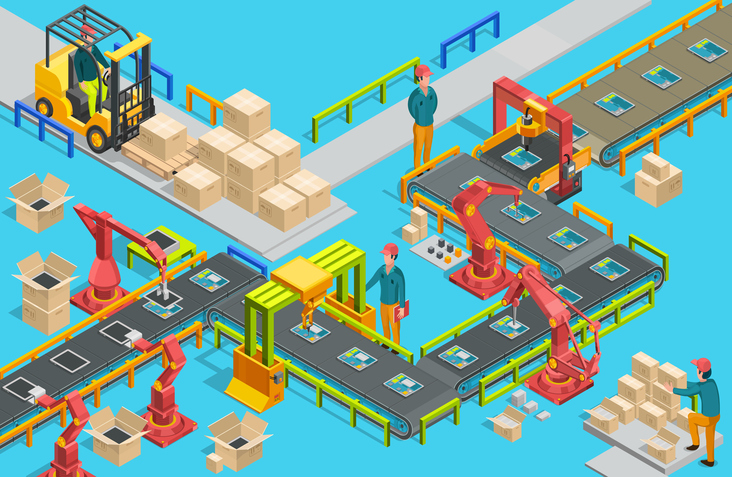How robotics has become the “future factory” of industry


Swaminathan Ramamurthy is the General Manager of the Robotics Business Division at Omron Asia-Pacific.
The use of robotics in industrial applications can be traced back to 1937 when Griffith “Bill” P. Taylor engineered a robot that was powered by a single electric motor. Following patterns on punched paper tapes, the robot could be pre-programmed to perform repetitive tasks such as stacking wooden blocks.
Fast forward 80 years to today, Bill’s innovation has evolved into a sine qua non of the modern manufacturing landscape. A robot’s ability to relieve humans from monotonous and laborious tasks such as material transport, lifting of heavy objects or assembly line work has helped to alleviate human resource shortages in various industries across the globe. This delegation of menial tasks to robots has also allowed human workers to take on more complex responsibilities in the factory.
Robots have also come a long way since the days of punched paper tapes and single motors. Equipped with sensors that can detect and process the ubiquitous amount of data available today, modern day robots are no more limited to playing mundane support roles. The progress of robotics and other advanced technologies such as artificial intelligence (AI), data analytics and Internet of Things (IoT) has instilled a sense of ‘human-free’ proactiveness that has transformed the way we work in the factory.
The data – 2.5 quintillion bytes of it
According to the World Economic Forum, the world produces 2.5 quintillion bytes of data a day and 90 percent of data today was produced in the last two years.
Naturally, much of this data is generated and collected on the factory floor. The challenge for many factory managers is to make use of the right data to drive efficiency, enhance production and improve on flexibility. The key to this may be with the robots working in the production line itself.
Robots equipped with advanced sensors can gather data from key sources of the production system. Smart adaptive algorithms allow robots to analyse and process data with quick efficiency. These days, advanced analytics and AI software allow robots to arrive at programmed actions based on the intelligence they discover. They can also ‘learn’ to improve on actions and derive the best course of action to take to drive efficiency and productivity.
For example, machines and robots can track a large amount of production variables through advanced analytics. This allows timely control of crucial production factors such as manufacturing accuracy and quality control that are not easily spotted by humans.
Through these sensing capabilities, robots and machines in factories today are empowered to make simple decisions, automatically improve on systems and be self-optimising in a way.
The brain – sensing what is unnoticeable
Manufacturers are deploying AI technologies and bringing an all-new level of automation to the factory floor. They are accelerating processes and improving flexibility.
Tesla deploys 47 robots in scanning stations to execute precise and efficient quality control of its Model 3 cars. These no-nonsense robots measure 1,900 points on each vehicle to ensure their alignment is no more than 0.15 millimeters outside design specifications.
When a Tesla car leaves the production line for its test drive, human workers at Tesla service centers also keep track of important data such as squeaks and noise that are captured by sound recorders. These faults, usually unnoticeable to the test driver, are linked with the car’s unique Vehicle Number (VIN). This allows problems to be more efficiently diagnosed with root causes able to be traced to the factory line.
For Tesla, the capabilities of these advance technologies are ad infinitum. The amount of vital data that is captured and connected with a car’s VIN can help service centers diagnose problems even when the car is in the customer’s garage.
Sense | Control | Think
The confluence of data, IoT and machines is not limited to processes such as assembly and quality control. Robots can be expected to participate in more crucial activities and take on more proactive roles due to their ability to sense and control production activities. The next step in this 80-year journey would be to harness robots that can think beyond the simple decisions they currently make.
However, instead of thinking for us, these robots will take on partnering roles in factories. Armed with an arsenal of advanced technologies, they will be able to complement their human colleagues with their ability to detect manufacturing failure signs and take steps against risks normally unnoticeable to human beings.
This human-robot interoperability is at the crux of the “4M sensing technology” framework envisioned by Omron’s researchers to provide an idea of the dynamics that will be commonplace in a future factory. This framework encompasses four critical factors of the modern factory – man, machine, material and method. It provides a foundation for humans and machines to work in the same environment.
These four factors are inter-connected through artificial intelligence and an exchange of information and knowledge between man and machine. The skilled human worker imparts valuable knowledge to machines who can reproduce their skills and ultimately become self-reliant. In return, robots and machines detect failure symptoms that can be unnoticeable even by skilled engineers.
This exchange of skills can also be extended to other functions and concerns of an organisation such as safety and human resources. Just as humans periodically inspect machines and robots for wear and tear that may otherwise compromise their ability to work effectively and safely, machines and robots can detect signs of bad health of a worker based on his/her movements and/or health data and immediately warn line managers.
The future – endless possibilities
With the explosion of data, future factories have more information to tap on than ever before. This has increased possibilities, in the way we can leverage on robots. As machines today advance in intelligence, they also gain in value. We are driving towards a future where humans and machines collaborate in factories and build on a new found symbiotic relationship.
As we look back to the early day robot that was powered by a single engine motor, one cannot help but wonder how much more progress will be seen in factories 80 years from now. Will factories be able to run independently without human intervention? Nothing seems impossible at this moment.



